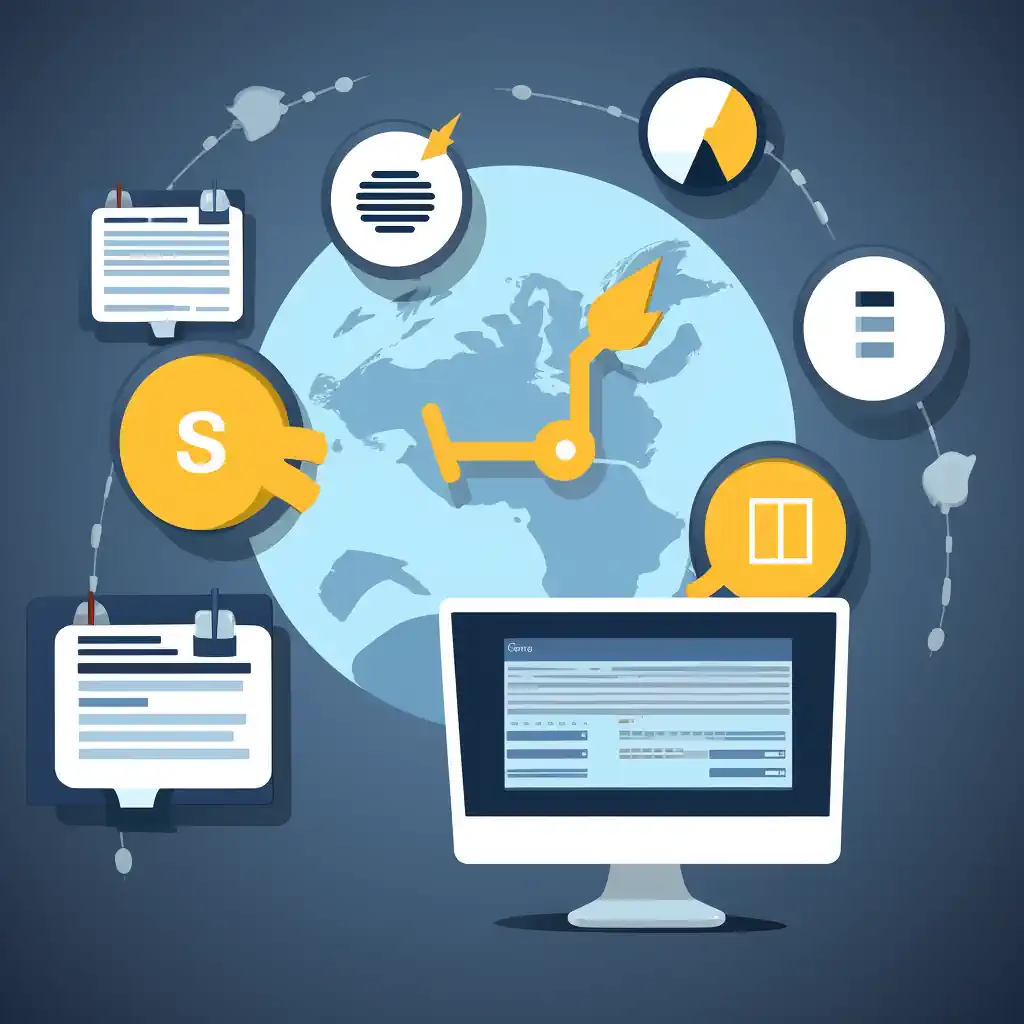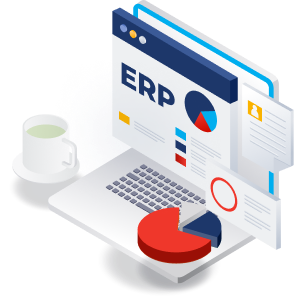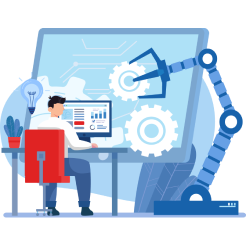
Following Proven Steps for Successful ERP Implementation
Implementing a new ERP system is a major undertaking that requires careful planning and execution to ensure success. However, research has shown that almost three-quarters of ERP projects fail to achieve the expected benefits due to poor planning, inadequate testing, or suboptimal user adoption when implementing ERP.
This article provides a comprehensive overview of the ERP implementation process and best practices to help your organization avoid common pitfalls. By investing sufficient time upfront in planning, assembling an experienced project team, and keeping end users involved, you can rollout your new system smoothly and realize substantial operational improvements.
ERP Implementation process
Implementing an Enterprise Resource Planning (ERP) system is a transformative experience that requires significant planning and hard work. Our team, AcuPower, follows the described steps in order to make sure that your company may use the new ERP. However, when carried out diligently, the change management process can result in improved efficiency, increased productivity, and better decision-making. The following blueprint for implementing an ERP system will provide you with invaluable insights, lessons, and tips on how to eliminate common pitfalls and make your project smooth sailing.
1. Needs Assessment and Goal Setting
Prior to beginning the process of implementing an ERP system, it is important to complete a comprehensive needs assessment to know what an organization requires and to identify the challenges and aims. During this step, departments get involved in order to gather input and get specific goals for the ERP system. The deliverable is a complete document that includes outlined goals for functionality, performance measures, and expressed business results.
2. Selection of the Right ERP System
At the heart of the ERP puzzle is the installation of the right software, and there is plenty of the right software out there. Factors for choosing just the right one include conducting a needs assessment and then asking several vendors for their opinions about what will work best. Consideration should be given to the specific industry, how easy the system is to use, how many modules it will accommodate, scalability, and how well the system can be customized. Your organization may ask for a demonstration or to pilot the software before purchase. Checking references is always a good proactive measure, researching the software and its effectiveness within that organization.
3. Project Planning and Team Formation
Effective project planning is critical to the success of an ERP implementation. First, a detailed project plan that outlines the scope, timeline, budget, and resource allocation should be developed. Second, a cross-functional project team should established, and the roles and responsibilities of team members should be clearly defined. The project team should be made up of project managers, IT staff, and key users from the various departments that the ERP system will impact.
4. Data Preparation and Migration
The data preparation and migration portion of the process is a long, exacting phase. This is where data is cleaned, mapped, and finally transferred from old systems to the new ERP software. The primary goal of this is to sustain data accuracy and integrity as the same is vital to the effectiveness of the system itself. Several test migrations may be done through this phase to identify and resolve issues with the data before the final data cut.
5. Customization and Integration
Although the ERP system comes with a number of predefined options, it is possible to customize the system to match your workflows or to be able to match your current application. However, most of the ERP experts will generally advise you to avoid any forms of customization as this will lead to having a complex ERP system, and every time there is an update, you will have problems updating the system.
On the other hand, it is good to have seamless integration of the system to be able to work with other systems, say the CRM. Such integration should be in such a way that any changes that were made in the ERP, should be reflected in the CRM as well.
6. User Training and Support
User training and support are two of the most important aspects of ERP implementation. Training programs should be organized for the different types of users to show them how their role will operate in the new ERP system. With help from a steering committee, the decision should be made as to how detailed the training should be. On the one hand, some feel if they were trained in the out-of-the-box software, then they would, in turn, be able to figure out other functionality the software had to offer.
On the other hand, some feel you need to know every little detail that the system has to offer. In-depth training could lead to a longer implementation process but could have the potential for a higher success rate with the software. Regardless of how long users are trained on the software, the user should always be trained adequately on the functionality of the software that is relevant to their role. In addition to user training, ongoing support must be provided to users after they go live.
There should be a help desk throughout the implementation process to assist users with issues. College Students love forms of online support, but the older you get, the more you appreciate a human being. There should also be user manuals and online training tools to help users out when they don’t remember how to do something. You will find that many minor issues can be resolved with a little bit of intervention. When there is an inability to solve a problem, maybe a slight redesign or a work around could possibly alleviate the problem.
7. Testing and Quality Assurance
Prior to going live, the ERP system must be just rigorously tested. This happens during unit testing when the developers are thoroughly testing each individual program's behavior to confirm it's behaving as expected. Then, the system is integrated, and system integration testing (SIT) is performed to verify all integrated components are functioning properly. Performance testing is the next type of testing to be performed. We must confirm that the new system will work well for the estimated number of end-users and the expected amount of transactions (data processing). The final type of testing is user acceptance testing (UAT). During UAT, end-users provide feedback about the future system. This can include any potential improvement and identify concerns.
8. Go-Live and Evaluation
The go-live process officially starts the utilization of the ERP in a live setting. It is smarter to choose a less busy period, it is a decent chance to conclude an arrange B in light of the fact that there will continuously be a few issues through implementation. Begin checking the framework performance as it were after you approve the move live.
9. Post-Implementation Review and Continuous Improvement
Once the business adopts the newly implemented ERP, it will eventually stabilize. Once the system is stable, it will be necessary to conduct a post-implementation review to evaluate project success, capture lessons learned, and further optimization areas. ERP implementation does not end at go-live. It is a continuous process of improvement for as long as the business is subject to change.
Why ERP Implementation Success Matters
Before diving into key steps for successful ERP implementation, it’s helpful to understand what’s at stake with implementing a new system. Selecting and deploying ERP software often represents one of the largest IT investments an organization will make. To give you a clue, implementing an ERP system may cost between 5k and a couple of million, depending on the type of ERP system you've selected, how long ERP implementation takes, and the implementation approach used.
Beyond the financial considerations, transitioning business systems and processes brings substantial disruption, at least in the short term. But this major effort pays dividends when done right – modern cloud-based ERP solutions help companies gain transparency, align teams, and streamline workflows by replacing fragmented legacy systems with integrated data and apps. So make sure that your business has prepared steps and processes in advance because if you refine them in runtime during ERP implementation, then the success of ERP will be measured.
However, because ERP platforms touch nearly all parts of an operation, if the implementation goes awry, the business risks grinding to a halt. Without the right ERP, inventory may lag, orders remain unfulfilled, payroll stalls, reporting becomes non-existent, and employees resort to their spreadsheets out of frustration.
Avoid this scenario by understanding the full implementation journey required to make your ERP project a success – for both technology and people. The good news is that by following the right steps and best practices and relying on proven project management approaches and change management practices from experienced partners; one can prevent common errors and successfully complete the ERP system implementation.

Assembling Your ERP Implementation Dream Team
Every successful implementation, especially of ERP systems, requires a complete team effort. Achieving project goals and desired ROI is only possible when the right groups are represented, responsibilities are clearly defined, and leadership is aligned.
Key roles that should actively participate in ERP implementation include:
Executive Sponsor – Because ERP initiatives require substantial investment and business change management, securing hands-on C-level endorsement is a must.
Project Manager – A dedicated manager should own the implementation plan, process, budget and cross-functional communication.
ERP Implementation Partner – Don’t underestimate the value of experienced consultants in making stage-by-stage recommendations and transferring knowledge to your staff.
Department Leads – Functional managers offer critical perspectives on current-state processes and define future requirements.
The right ERP technology leads. – IT maintains systems integrations, oversees security and manages data considerations vital for solution design.
Key Users - Power users across different business units provide ongoing feedback and champion the ERP implementation project within their sphere of influence after the cloud ERP solution goes live.
Covering these essential roles forms a project team (ERP implementation team) well-equipped to handle common ERP implementation challenges through collective knowledge and clear delineation of duties.
Crafting Your ERP Implementation Roadmap
With the team assembled, the next attention goes toward comprehensive project planning and creating the all-important ERP implementation roadmap to guide rollout. Defining timelines and ownership across these key phases drives momentum:
1. Conduct Current Process Evaluation
Before implementing an ERP, document existing workflows, data touchpoints, reporting needs, and pain points under legacy systems. Identify process and job role changes likely required when shifting to the enhanced integration and best practices coming with a modern ERP platform.
2. Set Future-State Objectives & Requirements
Outline the critical business scenarios and use cases your selected ERP platform must address to deliver value — both on day one and for future plans. Detail feature/function needs while separating true must-haves from nice-to-haves.
3. Design ERP Solution Architecture
With requirements set, conduct solution design sessions to determine system and ERP implementation cost and integration architecture. Establish which modules, roles, and data flows align to stated objectives. During the process of planning for an ERP implementation, it's important to develop prototypes, conduct testing sprints, and refine the architecture of the system.
4. Perform Data Migration Planning
To maintain operational continuity, existing databases, customer lists, product catalogs, accounts payable/receivable and more must migrate to the new ERP platform. Detail the extract-transform-load process through conversion sprints, validation checks and optimization.
5. Conduct User Training & Testing
Well ahead of going live, begin immersing departmental users into new workflows through hands-on training focused on role-based application navigation, process changes, support resources, and upcoming milestone expectations.
6. Go-Live!
With viable data, tested processes and equipped users -- go-live day has arrived. Adopt ERP implementation best practices, like having all hands on deck and support staff standing by as ERP usage moves from practice to production environments. Measure adoption, support ticket volume, and user sentiment.
7. Drive Continuous Improvement
In the weeks following the successful ERP implementation, gather user feedback on enhancements to streamline the new business process enabled by ERP. Expand self-service training content for ERP and continue evangelizing wins throughout the implementation process. Start planning for how to leverage unused features in the next project phases.
While unavoidable surprises still pop up, having a clearly mapped path makes navigating ERP complexities much more manageable throughout implementation and beyond.
Securing Buy-In Across the Business
Through the process of planning ERP implementation, it's noted that success requires technical readiness and a commitment that spans the entirety of the company. To secure buy-in, the project team should:
- Evangelize wins – Share future-state process maps with stakeholders to showcase how workflows will improve under ERP vs. current legacy environment.
- Address concerns – Provide forums for end users and department heads to surface apprehensions to be documented and discussed.
- Monitor sentiment throughout the ERP implementation to ensure a successful implementation. Conduct user surveys at each rollout milestone of the ERP implementation plan to measure engagement, virtual training tool adoption, and knowledge retention.
- Incentivize progress throughout the process. Recognize employee achievements in helping demo new ERP functionalities, documentation contributions, and proactive knowledge sharing with peers throughout the implementation timeline.
Getting the word out early and often builds confidence. Testing the system makes it easier to course correct if substantive feature resistance or adoption barriers emerge once personnel experiences the cloud ERP hands-on.
Choosing the Right Implementation Partner
Given IT staff constraints and limited exposure optimizing enterprise platforms, turning to experienced ERP implementation consultants, like those from Acumatica, is strongly advised. Relying on external experts means gaining:
Industry Know-How
Partners with niche specializations ensure your workflows and requirements receive informed guidance optimized for key scenarios within manufacturing, distribution, services, and beyond. Also, such an ERP project team will help you save time on delivery. One of the benefits of such an approach is the avoidance of common ERP implementation mistakes, as they may have already made or heard about mistakes that happened in the past.
Technical Chops or Cook Your Cloud ERP in the Right Way
Certified cloud architects design tailored solutions around core platform strengths while avoiding needless custom coding that complicates upgrades. Guidance on infrastructure requirements and integrations prevents surprises. Also, these guys will help you choose an ERP solution for your business, fine-tune and potentially correct the performance of the ERP system. Another facet may be a nontrivial process of installing, which should be straightforward for the technical team. They will suggest appropriate installation either for on-premises ERP installation, cloud-based installation, or hybrid installation. Taking into account these ingredients may lead to the cost of an ERP going down in comparison with newbies. I believe you've heard of saying, if you don't want to pay proffesionals, you'll pay for newbies. In the case of such an ERP system, the entire implementation may become a guinea pig for your company and for your implementers.
Project Management Skills
Structured project managers keep the ERP implementation project on pace via stage gates, assigned responsibilities, risk management, and over 10,000 collective partner hours executing implementations worldwide. In order to make sure that the implementation process goes smoothly, double-check which project management tools implementers use. In the case of AcuPower, we actively use Jira/Atlassian for tracking implementation. And besides that, practices for a successful ERP include certified consultants, certified developers, and curious minds about your business. Such allocation will deliver ERP implementation phases in combination with big steps, like Epic user stories, which will have a treeview structure with smaller sub-epics and digestive issues. Such a combination will make sure that the chosen ERP system will add value to your business.

Change Management Insights
Partners have a keen awareness of people-side challenges from leading many customers through technology change. Their best practice playbooks help ensure user adoption during the ERP implementation life cycle.
While leveraging experienced guidance, ownership for using provided tools and actively driving culture change rests with internal project sponsors. Partners excel at implementing an ERP, while organizations must champion adoption.
Conquering Complexities Through Consistent Communication
Across various steps covered, the essential theme is consistent communication. With numerous moving parts – from process design workshops to testing to parallel payroll operating precautions and contingency planning – keeping everyone in flow proves challenging.
To maintain alignment, the project manager acts as the main liaison to:
- Provide status updates against the overall plan – where milestones stand, which tasks risk falling behind, and what dependencies remain.
- During the ERP implementation project, it’s essential to identify knowledge gaps or pockets of resistance in your ERP vendor, requiring more attention from the successful implementation team.
- Offer reminders on upcoming training sessions, design reviews, and user preparation needs.
- Celebrate small wins and user contributions to build confidence.
- Keeping everyone – executives to end users – apprised of progress, risks and next steps maintains engagement critical for a smooth implementation.
Key Takeaways for Your ERP Implementation
Major undertakings like ERP adoptions can overwhelm, but breaking initiatives down into defined roadmap stages makes the complex manageable. Remember these best practices:
- Secure executive commitment with a sound business case
- Build a cross-functional project team and implementation partner
- Throughout the process, it's vital to chart project plans in detail, spanning from the solution design to the training and go-live stages.
- Communicate consistently at each step of the ERP implementation life cycle to align stakeholders.
- Incent user adoption and contribution to new workflows
ERP platforms promise incredible transformation – but a successful ERP implementation only occurs with diligent effort across technology, process, and company culture change. By following proven advice, your organization can also join the ranks of ERP implementation success!
If you are looking for an ERP vendor who can consult you on the ERP system for your custom business processes and workflows, reach out to AcuPower LTD. Leverage our advanced skills, deep knowledge, and industry insights for your business growth and strategic decision-making process.
Comments (0)
No comments yet
Be the first to comment
 Share on Facebook
Share on Facebook
 Share on LinkedIn
Share on LinkedIn
 Share on Twitter
Share on Twitter




 1460
1460

